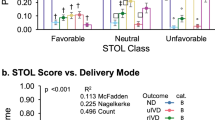Abstract
Objective:
We documented time to key milestones and determined reasons for transport-related delays during simulated emergency cesarean.
Study Design:
Prospective, observational investigation of delivery of care processes by multidisciplinary teams of obstetric providers on the labor and delivery unit at Lucile Packard Children’s Hospital, Stanford, CA, USA, during 14 simulated uterine rupture scenarios. The primary outcome measure was the total time from recognition of the emergency (time zero) to that of surgical incision.
Result:
The median (interquartile range) from time zero until incision was 9 min 27 s (8:55 to 10:27 min:s).
Conclusion:
In this series of emergency cesarean drills, our teams required approximately nine and a half minutes to move from the labor room to the nearby operating room (OR) and make the surgical incision. Multiple barriers to efficient transport were identified. This study demonstrates the utility of simulation to identify and correct institution-specific barriers that delay transport to the OR and initiation of emergency cesarean delivery.
This is a preview of subscription content, access via your institution
Access options
Subscribe to this journal
Receive 12 print issues and online access
$259.00 per year
only $21.58 per issue
Buy this article
- Purchase on Springer Link
- Instant access to full article PDF
Prices may be subject to local taxes which are calculated during checkout
Similar content being viewed by others
References
Pallasmaa N, Ekblad U, Aitokallio-Tallberg A, Uotila J, Raudaskoski T, Ulander VM et al. Cesarean delivery in Finland: maternal complications and obstetric risk factors. Acta Obstet Gynecol Scand 2010; 89: 896–902.
Shields L . Postpartum hemorrhage: lessons learned from other states. CMQCC Obstetric Hemorrhage Toolkit, Obstetric Hemorrhage Care Guidelines and Compendium of Best Practices Reviewed by CADPH-MCAH: 12/21/09 California Maternal Quality Care Collaborative 2009.
Al-Foudri H, Kevelighan E, Catling S . CEMACH 2003–5 Saving Mothers’ Lives: lessons for anaesthetists. Contin Educ Anaesth Crit Care Pain 2010; 10: 81–87.
Sentinel event alert issue 30. Preventing infant death and injury during delivery. The Joint Commission 2004.
Sentinel event alert issue 44. Preventing maternal death. The Joint Commission 2010.
ACOG practice bulletin no. 115: vaginal birth after previous cesarean delivery. Obstet Gynecol 2010; 116: 450–463.
Draycott TJ, Crofts JF, Ash JP, Wilson LV, Yard E, Sibanda T et al. Improving neonatal outcome through practical shoulder dystocia training. Obstet Gynecol 2008; 112: 14–20.
Lipman SS, Daniels KI, Carvalho B, Arafeh J, Harney K, Puck A et al. Deficits in the provision of cardiopulmonary resuscitation during simulated obstetric crises. Am J Obstet Gynecol 2010; 203: 179.e1–179.e5.
Lipman SS, Daniels K, Cohen SE, Carvalho B . Labor room setting compared with the operating room for simulated perimortem cesarean delivery: a randomized controlled trial. Obstet Gynecol 2011; 118: 1090–1094.
Maslovitz S, Barkai G, Lessing JB, Ziv A, Many A . Recurrent obstetric management mistakes identified by simulation. Obstet Gynecol 2007; 109: 1295–1300.
Siassakos D, Hasafa Z, Sibanda T, Fox R, Donald F, Winter C et al. Retrospective cohort study of diagnosis-delivery interval with umbilical cord prolapse: the effect of team training. BJOG 2009; 116: 1089–1096.
ACOG practice bulletin no. 116: management of intrapartum fetal heart rate tracings. Obstet Gynecol 2010; 116: 1232–1240.
Leung AS, Leung EK, Paul RH . Uterine rupture after previous cesarean delivery: maternal and fetal consequences. Am J Obstet Gynecol 1993; 169: 945–950.
Part 12.3: cardiac arrest associated with pregnancy. Circulation 2010; 122: S833–S838.
Part 10.8: cardiac arrest associated with pregnancy. Circulation 2005; 112: IV-150–I53.
Preston P, Lopez C, Corbett N . How to integrate findings from simulation exercises to improve obstetrics care in the institution. Semin Perinatol 2011; 35: 84–88.
Smith-Coggins R, Rosekind MR, Buccino KR, Dinges DF, Moser RP . Rotating shiftwork schedules: can we enhance physician adaptation to night shifts? Acad Emerg Med 1997; 4: 951–961.
Acknowledgements
We would like to thank Andrea Puck, RN, Nurse Education Specialist, Lucile Packard Children’s Hospital, for creating the OB Stat Nursing Roles cognitive aid included in the Supplementary Appendix, the leadership of Anne Marie Oakeson, Nurse Manager of the labor and delivery unit, Lucile Packard Children’s Hospital and the vision of Risk Management (The Alliance Group) at Stanford and Lucile Packard Children’s Hospital. No financial or other compensation was provided to any of the individuals or groups listed. No funding was received by any of the authors for this study.
Author information
Authors and Affiliations
Corresponding author
Ethics declarations
Competing interests
The authors declare no conflict of interest.
Additional information
Portions of this data were presented at the annual meetings of the Society for Obstetric Anesthesia and Perinatology (May 2009, Washington, DC) and the American Society of Anesthesiologists (October 2009, New Orleans, L.A).
Simulated in situ drills identified and led to remediation of institution-specific delays in initiating emergency cesarean delivery.
Supplementary Information accompanies the paper on the Journal of Perinatology website
Supplementary information
Rights and permissions
About this article
Cite this article
Lipman, S., Carvalho, B., Cohen, S. et al. Response times for emergency cesarean delivery: use of simulation drills to assess and improve obstetric team performance. J Perinatol 33, 259–263 (2013). https://doi.org/10.1038/jp.2012.98
Received:
Revised:
Accepted:
Published:
Issue Date:
DOI: https://doi.org/10.1038/jp.2012.98
Keywords
This article is cited by
-
Effect of in situ simulation training for emergency caesarean section on maternal and infant outcomes
BMC Medical Education (2023)
-
Leading change in practice: how “longitudinal prebriefing” nurtures and sustains in situ simulation programs
Advances in Simulation (2023)
-
GENESISS 2—Generating Standards for In-Situ Simulation project: a systematic mapping review
BMC Medical Education (2022)
-
Enhancing knowledge, skills, and comfort in providing anesthesia assistance during obstetric general anesthesia for operating room nurses: a prospective observational study
Canadian Journal of Anesthesia/Journal canadien d'anesthésie (2022)
-
Anästhesie in der Geburtshilfe
Der Anaesthesist (2016)



